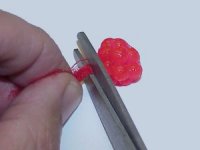How to cure and preserve roe from salmon or trout for bait.
For the best bait possible cure and preserve only fresh trout and salmon roe or eggs. You should always cure the salmon roe within 24 hours of catching the fish. If not kept cool and refrigerated the roe or eggs will spoil. If possible bleed the fish prior to collecting or removing the roe from the fish. The best method is to cut one or two of the gill plates. Blood in the roe or eggs can ruin the roe in less than an hour if not stored properly. Curing the salmon or trout roe allows you to store the roe in the refrigerator for a month or freezer for up to a year.

We collected roe from a Coho or Silver Salmon. Blood in the roe can ruin the roe in less than an hour if not stored properly. If there is excessive blood mixed with the roe use river water to gently rinse the roe. Drain all water. All blood must be removed before curing the roe. The eggs must then be kept cold.

Step 1: You will need a large plastic bowl, a plastic spoon, roe, paper towels, a plastic paint strainer, and a quality salmon roe cure.

Step 2: Drain all fluid from the roe. If there is any trace of blood, rinse the roe with distilled or river water. Do not use tap water with chlorine.

Step 3: Salmon roe ready for curing.

Step 4: Follow the directions on the product label. Generally you will sprinkle the cure on the roe. Do not use your hand or a metal spoon.

Step 5: Gently stir the roe to distribute the salmon roe cure evenly to all the roe.

Step 6: Gently transfer the roe back into the cleaned plastic jar.

Step 7: Fluid will start to be removed from the roe. (Do Not Drain, place the seal on the jar and place in your refrigerator overnight Use care with the curing fluid, it will stain most clothing.)

Step 8: The salt and several other preservatives that are in the commercial salmon roe cures cause osmosis to occur. Osmosis is the movement of a fluid through a semipermeable membrane into a solution of higher saline concentration that tends to equalize the concentrations of fluid on the two sides of the membrane.

Step 9: As the salmon roe cures in your refrigerator the fluid will be drawn from the eggs and mix with the enzymes and scents in the commercial salmon roe cure.

Step 10: When the density of the fluid inside the roe or egg and the fluid surrounding the egg equalize the process will reverse. Now osmosis will move the fluid and cure through the egg cell membrane into the egg.

Step 11: Overnight all of the fluid should be absorbed back into the roe. Now the commercial cure has penetrated the roe or egg.

Step 12: Gently spoon the cured roe into plastic bags. Curing salmon or trout roe allows storage n the refrigerator for a months or frozen for up to a year.

Salmon or trout roe cured with this process will have a plumper and softer texture than roe that had the fluid drained. This type of roe is best used in spawn sacks when still fishing as the eggs can break easily. The roe also will milk both the cure, scent and initial fluid into the water when used.
































